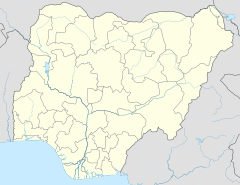
Kano is a city in northern Nigeria and the capital of Kano State. It is the second largest city in Nigeria after Lagos, with over ten million citizens living within 449 km2 (173 sq mi). Located in the Savanna, south of the Sahel, Kano is a major route of the trans-Saharan trade, having been a trade and human settlement for millennia. It is the traditional state of the Dabo dynasty who have ruled as emirs over the city-state since the 19th century. Kano Emirate Council is the current traditional institution inside the city boundaries of Kano, and under the authority of the Government of Kano State.

Nijō Castle is a flatland castle in Kyoto, Japan. The castle consists of two concentric rings (Kuruwa) of fortifications, the Ninomaru Palace, the ruins of the Honmaru Palace, various support buildings and several gardens. The surface area of the castle is 275,000 square metres, of which 8,000 square metres (86,000 sq ft) is occupied by buildings.

Katsina, likely from "Tamashek" or mazza (men) with "inna" (mother) is a Local Government Area and the capital city of Katsina State, in northern Nigeria.

Kano State is one of the 36 states of Nigeria, located in the northern region of the country. According to the national census done in 2006, Kano State is the most populous state in Nigeria. The recent official estimates taken in 2016 by the National Bureau of Statistics found that Kano State was still the largest state by population in Nigeria. Created in 1967 out of the former Northern Region, Kano State borders on Katsina State to the northwest for about 210 km, Jigawa State to the northeast for 355 km, Bauchi State to the southeast for 131 km, and Kaduna State to the southwest for 255 km. The state's capital and largest city is the city of Kano, the second most populous city in Nigeria after Lagos. The incumbent governor of the state is Abba Kabir Yusuf. He was sworn in on 29 May 2023.

Ado Bayero CFR, LLD, JP was the Emir of Kano from 1963 to 2014.
Ibrahim Shekarau is a former Nigerian minister of education and two-term Governor of Kano State in Nigeria. He was elected in April 2003 and re-elected in April 2007. He is a member of the Peoples Democratic Party (PDP). He was one of the candidates who aspired to become president in the Nigerian general elections of 2011.
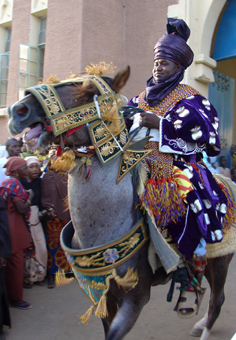
The Durbar festival is an ancient traditional annual Hausa; cultural, religious and equestrian festival, celebrated as a core part of the Arewa Hausa culture. Durbar has existed for centuries and is as an essential part of Hausa kingdom and Hausa tradition. Durbar is a paramount part of Hausa cultural rites, tradition and history and the Hausa's are renowned in history as ancient horsemen and warriors of the Sahara and the Sahel.
Muhammad dan Yakubu, known as Muhammad Rumfa was the Sultan of Kano from 1463 until 1499. His reign was characterized by wealth and opulence and signaled the rise of the Sultanate's commercial dominance in the region. According to the Kano Chronicle, a scholar Abdu Rahaman Muhammad al-Maghili came to the city of Kano during the reign of Rumfa to spread Islam. He brought with him many books. He ordered Rumfa to build a mosque for Friday prayers and to cut down the sacred tree and build a minaret on the site. And when he had established the faith of Islam, and learned men have grown in Kano, Abdul Karimi returned to Massar (Egypt), leaving Sidi Fari as his deputy to carry on his work

The Hausa are a native ethnic group in West Africa. They speak the Hausa language, which is the second most spoken language after Arabic in the Afro-Asiatic language family. The Hausa are a culturally homogeneous people based primarily in the Sahelian and the sparse savanna areas of southern Niger and northern Nigeria respectively, numbering around 86 million people, with significant populations in Benin, Cameroon, Ivory Coast, Chad, Central African Republic, Togo, Ghana, as well as smaller populations in Sudan, Eritrea, Equatorial Guinea, Gabon, Senegal, Gambia. Predominantly Hausa-speaking communities are scattered throughout West Africa and on the traditional Hajj route north and east traversing the Sahara, with an especially large population in and around the town of Agadez. Other Hausa have also moved to large coastal cities in the region such as Lagos, Port Harcourt, Accra, Abidjan, Banjul and Cotonou as well as to parts of North Africa such as Libya over the course of the last 500 years. The Hausa traditionally live in small villages as well as in precolonial towns and cities where they grow crops, raise livestock including cattle as well as engage in trade, both local and long distance across Africa. They speak the Hausa language, an Afro-Asiatic language of the Chadic group. The Hausa aristocracy had historically developed an equestrian based culture. Still a status symbol of the traditional nobility in Hausa society, the horse still features in the Eid day celebrations, known as Ranar Sallah. Daura is the cultural center of the Hausa people. The town predates all the other major Hausa towns in tradition and culture.

The Great Mosque of Kano is a general Jumaat mosque in Kano, the capital city of Kano State and the second most populous city in Nigeria. The mosque is situated at around the Heart of the city around the Mandawari area of the state.
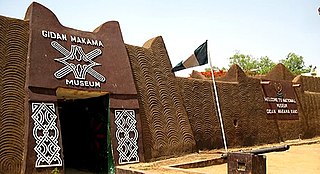
Gidan Makama Museum Kano or Kano Museum is a museum in Kano, Nigeria. This building served as temporary palace of Sarakunan Hausa of Kano before the current palace Gidan Rumfa was constructed in the 15th century The museum has a significant collections of arts, crafts and items of historic interest related to the Kano area. Located in a 15th-century historical building, which is recognised as a National Monument by the Government of Nigeria. The museum is divided into 11 galleries, each with their own centre of focus. Galleries include the Zaure or the main entrance hall with displays of traditional materials, city walls and maps of Kano, the history of statehood, Kano in the 19th century, the Civil War, economy, industry and music.
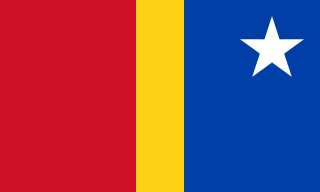
The Kano Emirate was a Muslim state in Northern Nigeria formed in 1805 during the Fulani jihad when the Muslim Hausa-led Sultanate of Kano was deposed and replaced by a new emirate which became a vassal state of the Sokoto Caliphate. During and after the British colonial period, the powers of the emirate were steadily reduced. The emirate is preserved and integrated into modern Nigeria as the Kano Emirate Council.
Tamburawa is a prominent town in Dawakin Kudu Local Government located fifteen (15 km) kilometres from Kano City in Kano State, Nigeria. The inhabitant of Tamburawa are Hausa, mostly lecturers, farmers, union workers, and businessmen. Irrigation farming is widely practiced. Tamburawa which is also known as Tamburawa Yamma, is a unique and homogeneous town. In the 2006 population census, Tamburawa and its remote villages were marked with a number of approximately 13,453 inhabitants. It is also divided into four major zones i.e. Kofar Arewa, Kofar Gabas, Kofar Yamma, and lastly Kofar Kudu. The people of Tamburawa have great enthusiasm for the game of football. It has a particular team that normally stands for the town in competitions or leagues that is Tamburawa United. The geographical location of Tamburawa is 11,52W 17,50E and 8,32 15.55E. standing 1450 ft above sea level. Tamburawa people of course practice child marriage in the community although they are said to be doing it according to the Shariah Law. Tamburawa is the centre of a prosperous, densely populated, agricultural region in which millet, rice, peanuts, and beans are produced. It is an important market centre for peanuts, livestock, grains, and other foodstuffs from the surrounding area. The people of Tamburawa are mostly followers of one religion, which is Islam. About 99.9% of the people are Muslims.
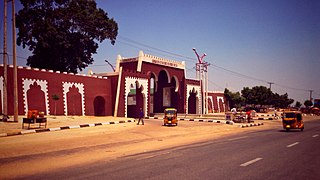
The Ancient Kano City Walls were ancient defensive walls built to protect the inhabitants of the ancient city of Kano. The wall was initially built from 1095 through 1134 and completed in the middle of the 14th century. The Ancient Kano City Walls were described as "the most impressive monument in West Africa".
Alhaji Tanko Yakasai OFR is a Nigerian politician, human rights activist and former Liaison Officer to President Shehu Shagari. He is a founding member of Arewa Consultative Forum.

Hausa architecture is the architecture of the Hausa people of Northern Nigeria and Niger. Hausa architectural forms include mosques, walls, common compounds, and gates. Hausa traditional architecture is an integral part of how Hausa people construct a sense of interrelatedness with their physical environment. The architectural program used in this society is one disciplined by Islam and results in a highly organized spatial structure which is used to express features of Hausa culture.

Mal Aminu Ado Bayero, was the 15th Fulani Emir of Kano from the Fulani Sullubawa clan. He ascended the throne on 9 March 2020, following the deposition of his nephew Muhammad Sanusi II by Governor Dr. Abdullahi Umar Ganduje. He is the chancellor of the University of Calabar.
Gates of Hausa kingdoms are gates or walls (ganuwa) that formerly enclosed Hausa kingdoms. In ancient times, each kingdom was enclosed with a wall that contained various gates. During battles, the gates were closed as a war strategy. Each gate has a name and a gatekeeper. In the past, especially at night, the gatekeeper was in charge of a single gate at all time. All of the gates are assigned to a single person today.
Ibrahim Khaleel Inuwa, also known as Engineer IK Inuwa, was a Nigerian politician, Kano State consultant, and a member of the Debate Coordinating Committee, that was chaired by Justice Niki Tobi on the Constitution of Nigeria (1999).

Babban Gwani, also known as Mallam Mikhaila, was an influential 19th-century Hausa architect and builder who flourished during the reign of the 61st ruler of Zazzau, Nigeria, Abd al-Karim ɗan Abbas. He was the Sarkin Maigini of his time, appointed by Shehu Usman dan Fodio. This position was passed down to his direct male descendants.

